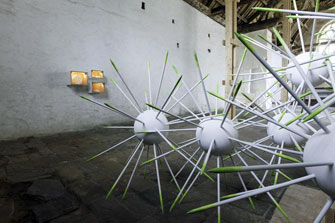Contemporary Religious Art:
Blasphemy or Blessing?

The Chapelle St Gildas in Bieuzy-les-Eaux.
If Puff the Magic Dragon ever joined the cast of “Sesame Street,” he might look like the mop-headed multipede by the artist Virginie Barré in the Chapel of the Trinity in Bieuzy – a village not quite by the sea, but not far from it, in the countryside of southern Brittany.
Barré, who lives and works in the fishing port of Douarnenez, is one of 20 artists showing works this year in chapels and churches, mostly dating from the 15th and 16th centuries, scattered around France’s Morbihan department, inland from Lorient and Vannes.
For the last 22 years, an association of local villages has organized an annual summer program, “Art in the Chapels,” which invites selected artists to create site-specific installations for sacred places – contemporary meets timeless in the land of Merlin and Arthur.
In that spirit, Barré’s dragon, a Japanese Yokai monster, shares kinship with the medieval bestiary carved into a roof beam of the Trinity Chapel.
About 6 kilometers away, in Pluméliau, the whitewashed walls of the Chapel of St. Nicholas appear to be spawning pods of egg-like spheres that, as they advance from the

An installation by Laurette Attrux-Tailau in the Chapel of St. Nicholas. © Stéphane Cuisset
walls, grow vicious spines, like giant sea urchins or naval mines. This is the work of Laurette Attrux-Tailau, a French artist now based in Brussels.
Another half-dozen kilometers along the road, the sea itself appears to have invaded Notre Dame des Fleurs, in Moustoir-Remungol, where the Parisian artist Edouard Sautai has spread a sheet of still, dark water across the floor to reflect the chapel’s stained-glass windows, niched saints and rough-beamed, wood-planked vaulted ceiling.
To help visitors find their way from site to site, by car or bike, the organizers have designed four circuits, each about 10 kilometers long and linking a half-dozen or so sites. A map of the circuits can be printed from the Web site – though you may need a strong magnifying glass to read it – and guides, at least in theory, should be present at each site to talk about the place and the art.
Click here to read all of this week’s new articles on the Paris Update home page.
Reader Reaction: Click here to respond to this article (your response may be published on this page and is subject to editing).
Click here for more C’est Ironique! columns.
Support Paris Update by ordering books from Paris Update’s Amazon store at no extra cost. Click on your preferred Amazon location: U.K., France, U.S.
© 2013 Paris Update”
Favorite